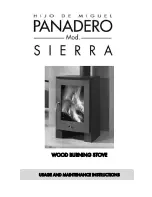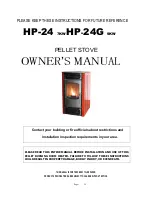
11
FUEL RECOMMENDATIONS
TYPE
WEIGHT
(LBS. CU. FT., DRY)
PER CORD
EFFICIENCY
RANKING
SPLITS
MILLIONS
BTU’s/CORD
Hickory
63
4500
1.0
Well
31.5
White Oak
48
4100
.9
Fair
28.6
Red Oak
46
3900
.8
Fair
27.4
Beech
45
3800
.7
Hard
26.8
Sugar Maple
44
3700
.6
Fair
26.2
Black Oak
43
3700
.6
Fair
25.6
Ash
42
3600
.5
Well
25.0
Yellow Birch
40
3400
.4
Hard
23.8
Red Maple
38
3200
.3
Fair
22.6
Paper Birch
37
3100
.3
Easy
22.1
Elm/Sycamore
34
2900
.2
Very Diffi
cult
20.1
Red Spruce
29
1800
.1
Easy
16.1
Th
e top down method of fi re building is recommended for this appli-
ance. Aft er making sure that the stove air intake controls are fully open
(completely pull-out towards you), Place the largest pieces of wood on
the bottom, laid in parallel and close together. Smaller pieces are placed
in a second layer, crossways to the fi rst. A third layer of still smaller
pieces is laid crossways to the second, this time with some spaces be-
tween. Th
en a fourth layer of loose, small kindling and twisted newspa-
per sheets tops off the pile. Higher effi
ciencies and lower emissions gen-
erally result when burning air dried seasoned hardwoods, as compared
to soft woods or to green or freshly cut hardwoods
DO NOT BURN:
1. Garbage;
2.
Lawn clippings or yard waste;
3.
Materials containing rubber, including tires;
4.
Materials containing plastic;
5. Waste petroleum products, paints or paint thinners, or asphalt
products;
6.
Materials containing asbestos;
7.
Construction or demolition debris;
8.
Railroad ties or pressure-treated wood;
9.
Manure or animal remains;
10. Salt water drift wood or other previously salt water saturated ma-
terials;
11. Unseasoned wood; or
12. Paper products, cardboard, plywood, or particleboard. Th
e prohi-
bition against burning these materials does not prohibit the use of
fi re starters made from paper, cardboard, saw dust, wax and similar
substances for the purpose of starting a fi re in an aff ected wood
heater.
Burning these materials may result in release of toxic fumes or render
the heater ineff ective and cause smoke.
Dead wood lying on the forest fl oor should be considered wet, and re-
quires full seasoning time. Standing dead wood can usually be consid-
ered to be about 2/3 seasoned. Splitting and stacking wood before it
is stored accelerates drying time. Storing wood on an elevated surface
from the ground and under a cover or covered area from rain or snow
also accelerates drying time. A good indicator if wood is ready to burn
is to check the piece ends. If there are cracks radiating in all directions
from the center then the wood should be dry enough to burn. If your
wood sizzles in the fi re, even though the surface is dry, it may not be
fully cured, and should be seasoned longer
Th
ere are ONLY two types of coal allowed for use in this furnace: Bitu-
minous Coal (soft coal) and Anthracite Coal (hard coal). NEVER USE
Cannel (or Channel) coal or Brown (Lignite) Coal.
See our Bulletin RC454 on the following pages for the best information
available on burning coal.
Any type of wood may be used in your stove, but specifi c varieties have
better energy yields than others. Please consult the following table in
order to make the best possible choice.
WOOD FUEL UTILIZATION
It is EXTREMELY IMPORTANT that you use DRY WOOD only in
your wood stove. Th
e wood should have dried for 9 to 15 months,
such that the humidity content (in weight) is reduced below 20% of the
weight of the log. It is very important to keep in mind that even if the
wood has been cut for one, two or even more years, it is not necessarily
dry, if it has been stored in poor conditions. Under extreme conditions
it may rot instead of drying. Th
is point cannot be over stressed; the
vast majority of the problems related to the operation of a wood stove
is caused by the fact that the wood used was too damp or had dried in
poor conditions. Th
ese problems can be:
- ignition problems
- creosote build-up causing chimney fi res
- low energy yield
- blackened windows
- incomplete log combustion
Smaller pieces of wood will dry faster. All logs exceeding 6” in diameter
should be split. Th
e wood should not be stored directly on the ground.
Air should circulate through the cord. A 24” to 48” air space should be
left between each row of logs, which should be placed in the sunniest
location possible. Th
e upper layer of wood should be protected from the
elements but not the sides.
When the stove is thoroughly warmed, place one piece of split wood
(about fi ve inches in diameter) parallel to the door on the bed of red
embers.
TESTING YOUR WOOD
Keep the air control full open and close the door. If ignition of the piece
is
accomplished within 90 seconds from the time if was placed in the
stove, your wood is correctly dried. If ignition takes longer, your wood
is damp.
If your wood hisses and water or vapor escapes at the ends of the piece,
your wood is soaked or freshly cut. Do not use this wood in your stove.
Large amounts of creosote could be deposited in your chimney, creating
potential conditions for a chimney fi re.







































